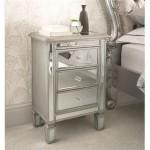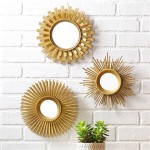Wall Mirror Design Patterns: Enhancing Space and Aesthetics
Wall mirrors are more than just reflective surfaces; they are powerful design tools capable of transforming the spatial perception and aesthetic appeal of any room. Their ability to manipulate light, create the illusion of increased space, and serve as decorative focal points makes them a versatile element in interior design. Choosing the right wall mirror requires careful consideration of various factors, including size, shape, framing, placement, and overall design style. Different design patterns can be employed to maximize the impact of wall mirrors and achieve specific design objectives.
This article explores various wall mirror design patterns, providing insights into how they can be effectively utilized to enhance the functionality and visual appeal of diverse interior spaces. It delves into different approaches to mirror placement, framing techniques, and stylistic considerations, offering a comprehensive understanding of how to leverage wall mirrors as key components of interior design.
Strategic Placement for Optimal Impact
The placement of a wall mirror is paramount to its effectiveness. A poorly positioned mirror can be ineffective, or even detrimental, to the overall aesthetic of a room. Strategic placement involves considering factors such as the direction of natural light, existing architectural features, and the desired visual effect.
One common strategy is to position a mirror opposite a window. This amplifies natural light, making the room feel brighter and more spacious. The reflected view from the window can also add depth and visual interest, effectively extending the perceived boundaries of the room. The size of the mirror should be proportional to the size of the window; a large mirror opposite a small window might overwhelm the space, while a small mirror might not adequately capture and reflect the light.
Mirrors can also be strategically placed to highlight architectural features. For example, a long, narrow mirror placed along a hallway can accentuate its length. A mirror placed above a fireplace mantel can draw attention to this focal point, creating a sense of grandeur. Similarly, a mirror placed near artwork or decorative objects can reflect these elements, creating a layered and visually rich effect. The key is to ensure that the mirror reflects something aesthetically pleasing and contributes to the overall harmony of the space.
In smaller rooms, mirrors are particularly effective at creating the illusion of more space. A large mirror covering an entire wall can effectively double the perceived size of the room. However, it is important to consider what the mirror will reflect. If the mirror reflects a cluttered or unattractive area, it will simply amplify the problem. Therefore, careful planning is essential to ensure that the mirror reflects a positive and visually appealing aspect of the room. Alternatively, clustered smaller mirrors can provide a similar expansive feel without overwhelming the room.
Consideration should also be given to the height at which the mirror is mounted. Generally, the center of the mirror should be at eye level. This ensures that the mirror is functional and aesthetically pleasing. In rooms with high ceilings, a taller mirror may be appropriate to balance the proportions of the space. In hallways or narrow spaces, a longer, horizontally oriented mirror can create a sense of width.
Framing Techniques and Stylistic Considerations
The frame of a wall mirror plays a crucial role in its overall aesthetic. The frame not only protects the edges of the mirror but also contributes significantly to its style and visual impact. The choice of framing material, color, and design should complement the existing decor and enhance the overall design scheme.
A wide variety of framing materials are available, ranging from classic wood and metal to more contemporary options such as acrylic and composite materials. Wooden frames can evoke a sense of warmth and traditional elegance. The type of wood, finish, and detailing can further contribute to the specific aesthetic. For example, a dark, ornate wooden frame can complement a formal or traditional room, while a light, minimalist wooden frame can suit a more contemporary or Scandinavian-inspired space.
Metal frames offer a sleek and modern aesthetic. Options such as brushed nickel, chrome, and brass can add a touch of sophistication and elegance. Metal frames are particularly well-suited to contemporary and industrial-style interiors. The thickness and design of the metal frame can also vary, from thin and minimalist to bold and geometric, depending on the desired visual effect. Powder-coated metal frames offer a durable and versatile option, available in a wide range of colors to complement any color scheme.
Frameless mirrors offer a clean and minimalist look. These are particularly well-suited to modern and contemporary spaces, where the focus is on simplicity and functionality. Frameless mirrors can also be used to create a seamless and expansive effect, particularly when used in large sizes. The edges of frameless mirrors can be beveled or polished for a more refined look.
The color of the frame should also be carefully considered. A frame that complements the wall color can help the mirror blend seamlessly into the space, while a contrasting frame can create a focal point and add visual interest. For example, a gold frame can add a touch of glamour and sophistication to a room, while a black frame can create a bold and dramatic contrast. When selecting a frame color, it is important to consider the existing furniture, accessories, and overall color palette of the room.
Beyond materials and colors, the style of the frame can also significantly impact the overall aesthetic. Ornate and decorative frames can add a touch of luxury and grandeur, while simple and minimalist frames can create a more understated and contemporary look. The choice of frame style should reflect the overall design style of the room and the desired visual effect.
Leveraging Shape and Size for Visual Harmony
The shape and size of a wall mirror are critical factors that influence its visual impact and functionality. Different shapes and sizes can be used to create different effects, from adding drama and grandeur to enhancing symmetry and balance. Careful consideration of these factors is essential to achieving a harmonious and visually appealing design.
Rectangular mirrors are a classic and versatile choice. They can be used in a variety of settings, from bathrooms and bedrooms to living rooms and hallways. Rectangular mirrors are particularly effective at creating a sense of height and width. A tall, vertically oriented rectangular mirror can visually elongate a room, while a wide, horizontally oriented rectangular mirror can create a sense of spaciousness.
Square mirrors offer a sense of balance and symmetry. They are often used in pairs or in symmetrical arrangements to create a sense of order and harmony. Square mirrors can also be used as accent pieces, adding a touch of geometric interest to a room. The size of the square mirror should be proportional to the surrounding space to avoid overwhelming the room or appearing too small and insignificant.
Round mirrors add a touch of softness and elegance to a space. Their curved shape contrasts with the sharp lines and angles of most architectural elements, creating a visually pleasing effect. Round mirrors are particularly well-suited to bathrooms and bedrooms, where they can add a sense of tranquility and relaxation. They can also be used as focal points in living rooms or hallways, adding a touch of visual interest and personality.
Oval mirrors offer a similar aesthetic to round mirrors but with a slightly elongated shape. They can be used to create a sense of height and elegance, particularly when hung vertically. Oval mirrors are often used in formal settings, such as dining rooms and entryways, where they can add a touch of sophistication and grandeur.
Irregularly shaped mirrors, such as those with organic or abstract forms, can add a touch of whimsy and artistic flair to a space. These mirrors are often used as decorative accents, adding visual interest and personality to a room. However, it is important to use irregularly shaped mirrors sparingly, as they can easily overwhelm a space if not carefully integrated into the overall design scheme.
The size of the mirror should be proportional to the size of the wall on which it is hung and the surrounding furniture. A large mirror on a small wall can overwhelm the space, while a small mirror on a large wall can appear insignificant. The mirror should also be positioned at a height that is comfortable and functional for the user. Generally, the center of the mirror should be at eye level. By carefully considering the shape and size of the mirror, it is possible to create a visually harmonious and aesthetically pleasing space.

How To Choose The Ideal Wall Mirror For Your Room Majestic Glass

Akollection Interior Design S Afroditi Mirror Wall Decor Living Room

10 Mirror Wall Panel Design Ideas Catalogue Know Cost Saving Tips

American Express

Round Frameless Wall Mirror Antiqued With Interesting Design Pattern And Handmade Finish Unique

Hexagon Mirror Wall Stickers 20cm Size Acrylic Hex Art Diy Home Decorative Hexagonal Sheet Plastic Tiles For Living Room Bedroom Sofa Tv B Decor

Elegant Leaf Pattern Round Metal Wall Mirror Accent Bedroom Dining Room

Schuller Nadia Wall Mirror Gold Leaf 120x90cm

Leaves Pattern Mirror Round Wall Writings On The

Diy Wall Mirror Sticker Feather Pattern Lia S Room








